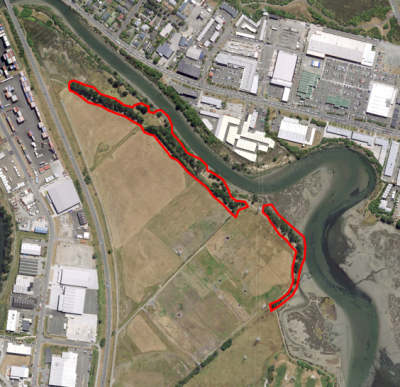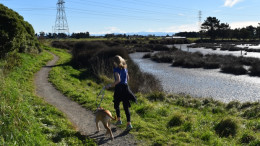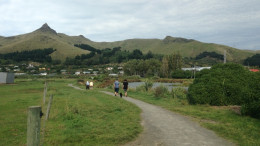Ferrymead Park is made up of 76 hectares of open area – perfect for kicking a ball, exercising the dog or taking advantage of one of the attractive walkways detailed below.
Enjoy one of the dedicated walking tracks or explore the wider area, rich in history, culture and nature.
Access
Bridle Path Rd off the Ferrymead end of Ferrymead Park Drive, Ferrymead
Metro info(external link) has up-to-date bus information.
Gate and open times
- Gates are open from 8am to 9pm, year-round.
- Ring Christchurch City Council on 0800 800 169 or 941 8999 to release locked in vehicles, at owner's expense.
Dogs
Dogs must be on a leash on all formed paths and tracks as well as in car parks and on roads. This includes both the Ōpāwaho River Track and Matuku Lakes Loop Track.
Dogs are allowed off leash on the sports fields, unless the fields are in use in which dogs are prohibited.
Dogs are prohibited from anywhere else in Ferrymead for the protection of wildlife.
A long time ago, Ferrymead, like much of Christchurch, would have been made up of wetlands and waterways. Before Christchurch was urbanised, the Ōpāwaho/Heathcote river habitat was lush and abundant in harakeke (flax), raupo and ferns.
Tuna (eels), lamprey, whitebait, mussels and koura (crayfish) flourished and were a great food source for local Māori. The river and surrounding forest was an important mahinga kai (food gathering site) and waterway for travelling around Canterbury by canoe.
Ferrymead is also an important suburb in the history of Christchurch city. When the early colonists arrived by ship in Lyttelton, they had to cart their belongings over the steep Bridle Path to Heathcote, where punts were used to cross the river into Christchurch.
In later years, goods were transported by sea up the estuary – an expensive exercise that cost more than bringing cargo from the UK to Lyttelton. The first railway in New Zealand opened in 1863 and ran from Ferrymead into central Christchurch.
For an in-depth history of the area, visit Ferrymead Heritage Park(external link). The Edwardian-style attraction features an early 1900s town complete with restored cottages, a schoolhouse, a church, businesses and an operating steam train once a month.
Get involved in your local park by volunteering with Forest and Bird at Calder Green Reserve(external link), a saltmarsh nestled on the lower Ōpāwaho/Heathcote river.
Forest and Bird aim to maintain an open sanctuary for the protection of endemic flora and fauna of the area.
Enjoy a river or lake-side stroll at Ferrymead Park on one of the tracks below:
We have developed a two stage plan for Ferrymead Park in consultation with various Council Units, Mahaanui Kurataiao Ltd, the Ngāi Tuāhuriri Kaitiaki Committee, key stakeholder groups, users of the park and the Heathcote Community Association.
Download development maps for stage one [PDF, 3.4 MB] and stage two [PDF, 3.4 MB].
As part of stage one, we are removing the large stand of pine trees along the bank of the lower Ōpāwaho Heathcote River. The area will be replanted with almost 12,000 native plants this season to create a restored corridor of indigenous vegetation along the Ōpāwaho River Track.
Species will include marsh ribbonwood, mingimingi, mānuka, kānuka, tōtara and ake ake.

Pine trees being removed.
The project has been assessed by the Council Biodiversity Team who have reviewed the pine trees and their ecological value to the area. A small number of existing trees will be left for roosting for the local birdlife. The other exotic trees are recommended for removal to allow for a more appropriate forest type to be developed.
Works will begin on Monday 15 July and run for approximately six weeks. Most of the Ōpāwaho River Track, the walkway between Tunnel Road and Ferrymead Park Drive, will be closed during this time.
In future years we will begin to restore the adjacent paddocks at Ferrymead Park to coastal wetland and shrubland habitat. Areas of the paddocks have become wetter and contain naturally occurring saltmarsh vegetation - some of which are threatened species. By gradually removing grazing and allowing those areas to revert (either naturally or through assisted regeneration) to indigenous plant communities we hope to develop a large area of coastal habitat that supports native biodiversity.
The works have been approved by the Waihoro Spreydon-Cashmere-Heathcote Community Board as part of the Ferrymead Regional Park Development Plan.



